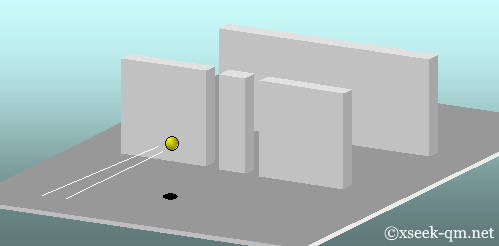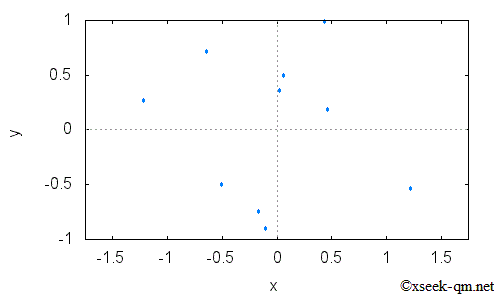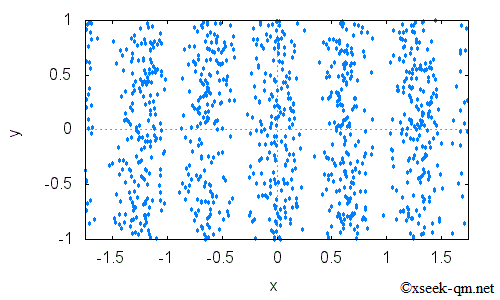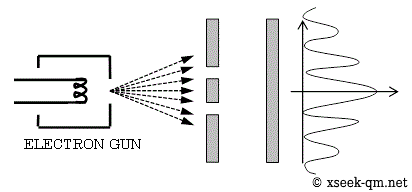This site serves as a gateway to the world of quantum theory. We aim to write articles that even readers unfamiliar with physics can understand. We hope it sparks your interest in quantum theory.
Let's begin by introducing the famous double‑slit experiment in quantum mechanics.

In the figure above, electrons are fired toward a wall that has two slits. An electron either hits the wall or passes through one of the slits. Those that pass through strike a second wall behind it. What happens when many electrons pass through the slits? As shown in the next figure, several electrons hit the back wall.

As we increase the number of electrons, the distribution changes as follows.

A striped interference pattern appears in the image above. When we graph the electron distribution, it looks like this:

These stripes arise because electrons behave like waves. The waves passing through the two slits overlap and alternately reinforce and cancel each other—a phenomenon known as interference. Wave interference produces the striped pattern. This phenomenon is known as the double‑slit experiment. It is truly puzzling that electrons pass through the slits one at a time, yet still form an interference pattern.
We describe the electron’s wave by the following function:
This function is called the wave function and is pronounced “psi of x.” The variable x represents the electron’s position. The wave function takes complex values and describes the electron’s state.
In the double‑slit experiment, the electron has two possible paths. The first path passes through the right slit; the second path passes through the left slit. We denote the wave function for the wave passing through the right slit as ΨR(x) and for the left slit as ΨL(x). We add these two wave functions:
Adding them produces interference, a principle called superposition. The probability P(x) of detecting the electron is the square of the magnitude of the wave function:
Why is the detection probability the square of the wave function’s magnitude?
In 1965, physicist Richard Feynman wrote the following in The Feynman Lectures on Physics, Volume III:
One might still like to ask: "How does it work? What is the machinery behind the law?"
No one has found any machinery behind the law. No one can "explain" any more than we have just "explained." No one will give you any deeper representation of the situation. We have no ideas about a more basic mechanism from which these results can be deduced.
In other words, the mechanism remains unknown. From the textbook Introduction to Gauge Theory, here is a 1951 quotation from Einstein:
All the fifty years of conscious brooding have brought me no closer to the answer to the question, "What are light quanta?" Of course today every rascal thinks he knows the answer, but he is deluding himself.
Through this site, I hope we can explore the wonders of quantum theory together.
© 2002, 2014 xseek-qm.net
広告


